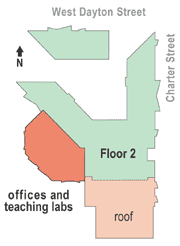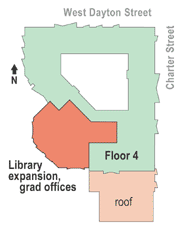Weeks 3: The West Wing Addition
If you have been reading the department's yearly Outcrop, you have heard about the planned addition to Weeks Hall. John Valley wrote the following in the 1999 issue: “Since moving into Weeks Hall, the department has never had enough laboratory or classroom space. Furthermore, the success of the museum and the changing needs of the library require expansion and more student study space, respectively. In 1999, the Geology and Geophysics Alumni Board decided to make the addition its top priority and this has been met with strong matching support by Chancellor David Ward, Deans Phillip Certain of Letters and Science and Virginia Hinshaw of the graduate school, and the trustees of the Wisconsin Alumni Research Foundation.
In that same issue, newly installed Chair Mary Anderson announced that the department had received permission from the university to build an addition to Weeks Hall. Three million of the estimated five-million-dollar addition had been provided by a 1.5 million dollar grant from WARF, with an equal match from the College of Letters and Science. The funds were to support continued research excellence within the department. The department will contribute money from its endowment funds, and the Alumni Board (now called the Board of Visitors) is heading a development campaign to raise additional funds.
The simple statements in the foregoing paragraphs belie the intense work and complicated negotiations that John Valley, Mary Anderson, and others, accomplished by the time the 1999 Outcrop went to press.
|
I got involved much later when the department was casting about for someone to chair the addition's building committee. I had served on the building committee for Weeks 1, the original research building that was constructed in 1972. And I chaired the building committee for Weeks 2, the teaching addition that was added in 1979. I am proud to have been associated with those two projects; many geologists spend a whole career without having the opportunity to see an idea of a building progress through to construction. A building committee deals with lots of details and tedious processes—and I have winced to hear the younger staff deride the lovely 1970s earth tone colors that we built into Weeks 1—so I hoped another might volunteer for the job. As you can infer, no one did. Therefore in the spring of 2000, I agreed to spend the last couple of years before retirement working on the project. As I recall, I only had to promise not to include earth tones on the walls or hot red colors for the interiors of any new elevators. |
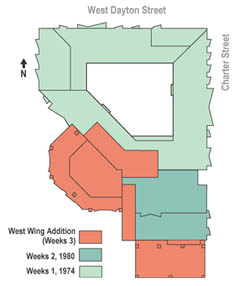 |
The Weeks 3 Building Committee, as presently constituted, is composed of Mary Anderson, John Valley, and myself from the faculty; Marie Dvorzak from the library, Klaus Westphal and Richard Slaughter from the museum, and Ben Abernathy, Teresa Egan, and Lee Powell from our technical staff.
Together Weeks 1 and Weeks 2 comprise about 120,000 gross square feet of floor area. The building is four stories plus a full basement level. It houses offices, a large lecture hall, classrooms, laboratories, museum, library, as well as storage and support facilities. In 2000 the Geology and Geophysics faculty approved the concept that Weeks 3 was to contain 12,300 assignable square feet of space apportioned as follows:
|
•
Geomicrobiology lab and office space:
|
3,300 (assignable square feet) |
|
•
Museum extension and remodeling:
|
2,550 |
|
•
Library extension and remodeling:
|
1,500 |
|
•
Lecture room (high tech), 75 students:
|
1,500 |
|
•
Sample repository /compact storage:
|
1,000 |
|
•
Undergrad lab:
|
600 |
|
•
Computer lab/seminar room:
|
500 |
|
•
Postdoc offices:
|
750 |
|
•
Visiting professor and emeritus offices:
|
600 |
|
Total:
|
12,300 assignable square feet |
The department’s Weeks 3 committee had an informational meeting with Rose Barroilhet, and Peter Heaslett of Facilities Planning Management, and Judy Craig and Chris Bruhn of L&S Administration on June 13, 2000. We learned that before a consultant A/E (architect/engineer) could be hired, the building proposal had to be approved by the Board of Regents at their August meeting; the proposal would then move “downtown” where the State would put together the necessary materials to call for a bid for an A/E and—after a sufficient time—choose the firm with the most effective proposal. At this early stage, it was thought that the Weeks 3 committee might actually sit down with an architect in early January 2001. As it turned out the A/E bids were advertised in March 2001, and one of the applicants, HSR Associates, Inc. of Madison, WI, headed by James Gersich, was selected by the State at a meeting on May 10. Our Weeks 3 committee actually first sat down with the architect on June 20, 2001, and things have moved along at a rapid rate ever since.
The architects take the proposed room spaces, and they attempt to work them into a harmonious solution whereby all the bits and pieces blend to a coherent whole that fits nicely with the existing building and conforms to the budget. It goes without saying that corridors and utility spaces will increase the final area well above the 12,300 ASF mentioned above.
The architects have a good deal of freedom, but also some major constraints; after all, the museum and library additions must adjoin their existing counterparts. In our case there are good practical reasons why all four floors and basement cannot have the same floor area. While it appeared from the start that Weeks 3 would attach to both Weeks 1 and 2 in the parking lot to the southwest of the existing structures, a number of iterations were tried before the Weeks 3 committee approved a solution at the end of 2001. A massive set of “Draft 35% Division of Facilities Development Submittal Design Reports” that include specifications for all rooms and equipment, soil boring and survey data, in-progress engineering plans for demolition, structural, electrical, heating and air-conditioning, plumbing, and landscaping are now making their way through University and State offices for comments and approval.
Let us work our way through the various floors of Weeks 3 to see how they tie in with Weeks 1 and 2. The addition will be of concrete frame construction with masonry cavity walls, membrane roof, and masonry and metal stud and gypsum board partitions. (Weeks 1 and 2 were of steel frame construction.) Concrete pillars whose positions are shown on the accompanying floor-plan illustrations will support the upper floors.
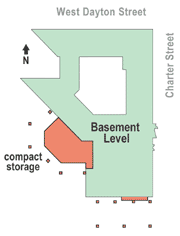 |
The basement level—which because of the slope of the land at the south side of the Weeks Hall site is the parking-lot level—will house additional compact storage for department/museum material. The floor will also contain the addition’s mechanical room and emergency generator. The size of basement level is relatively small so that it does not interfere too much with truck access to the Weeks 1 dock, which will be rebuilt to include a power lift. (When Weeks 2 was built, a parking lot window well with some landscape plants was found to be too arid to sustain life. Weeks’ occupants with surplus thesis rocks found the window well a useful discard area; serendipitously, the museum visitors’ children thought this a wonderful place to gather rocks. |
The “museum’s rock pile” will be displaced by Weeks 3, so we asked the architect to provide another shaded concrete enclosure for discarded rocks. I later noticed on the plans that the rocks in the old site were to be removed and stockpiled until put in the new location. I notified the A/E that we did not want the old rocks saved; we have enough new ones each year to be able to start from scratch!)
|
The first floor level of Weeks 3 will house a 75-seat high-tech lecture room, which we need for courses for majors and graduate students. This lecture room will be accessible both from the Weeks 1 lobby (using Herb Wang’s present office as a corridor) and from the museum lobby. The eastern side of the museum lobby, by the globe, will also have a widened access to the courtyard entrance. The addition to the museum will also be on the first floor, but it will be separated from the rest of Weeks 3. In order to match the high ceiling of the museum the addition will extend over the driveway at the south side of Weeks 2. It will be supported by concrete pillars and be high enough to allow trucks to pass underneath. |
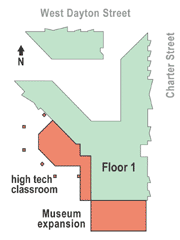 |
| Aside from increasing display space, the addition will also include some offices and an enhanced preparation area, which, with windows, will serve as another exhibit. The old preparation area in Weeks 2 will be remodeled to become a meeting room for museum activities. | |
The floor plan of Weeks 3 increases in area starting at the second floor. In an early design the upper floors had different dimensions according to different program needs. The committee asked the A/E to keep the exterior walls vertical to simplify construction and to avoid overhangs, which are always candidates for leaks. This resulted in a slightly larger building, but it provided many design advantages.
|
|
The second floor contains two classrooms, about a dozen variably sized offices (one a replacement office for Herb Wang), and a set of restrooms. The corridor serving this area ties into Weeks 1 near the Cline Lounge and to Weeks 2 on the balcony level by the undergrad labs. One of the new classrooms will be used for the new courses for majors, and the other will be developed as a modern graduate seminar room. We have asked that a small office space with a nice west-facing window be left as an alcove for people to use as a mini lounge; this could be converted into an office later, if needed. |
|
The third floor was originally conceived as a geomicrobiology laboratory complex for Jill Banfield. Her productive research and need for space resulted in labs that were scattered about Weeks 1. The addition would allow her to pull these satellite labs into one area that would be much for efficient for all concerned. Although Jill Banfield ultimately decided to move to another university, the department wishes to maintain expertise in this active field of research. Because we will be hiring in this field, we thought it would be an attractive incentive if the potential faculty member could specify the details of the labs and office space of the geomicrobiology facility.
|
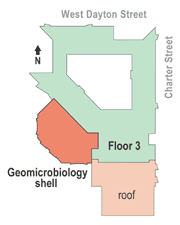 |
For that reason we are providing the infrastructure for the lab and office complex, but keeping most of this floor as a “shell” that will be finished later using funds set aside for the purpose. The corridor for this floor will tie into Weeks 1 by the freight elevator. It will connect to Weeks 2 by the classroom A341. A set of restrooms is also scheduled for the area—the first ever on a third floor of Weeks Hall!
|
|
The fourth floor of Weeks 3 will consist of an extension of the Geology and Geophysics Library, its second since Weeks 1 was completed. Whether they know it or not, future library patrons will actually be in Weeks 3 when they use the large new area of compact shelving. It will be divided into two parts, one large and the other small. These units will have a single “movable corridor” similar to the compact storage areas in the basement of Weeks 1 and 3, but they will be of library-grade construction. These units will contain reference materials that are used less often than those kept on open shelves. The floor under these compact units will be built to withstand a very heavy load. The library will also have a new small glass-walled office to help oversee a study area made from an area once used for shelves. This same area will also contain two small glass-walled rooms where groups can work together on projects without bothering others. |
The outer periphery of the fourth floor of Weeks 3 will consist of eight offices, another meeting alcove, and a future lab space, which will be kept as unfinished “shell” until needed. This floor’s corridor will not connect with the library (except by a one-way fire exit); rather it will connect with Weeks 1 near the freight elevator and the outside balcony. The corridor’s other end will connect to the west stairway of Weeks 2, which will be extended to the fourth floor.
With the addition of corridors, utility rooms, restrooms, and with remodeling of parts of Weeks 1 and 2, the project presently contains a gross area of 25,540 square feet, and it contains an assignable area of 15,428 square feet for a building efficiency of 60.4%. So far the estimated cost remains at five million dollars. As I mentioned earlier, we are now in the “35% DFD Submittal” phase where all parties are looking at details and offering suggestions. No doubt plan changes will occur, but we want to let you know where things stood when 2001 ended. Let me say what an honor it is to be working on this project with the cooperation of so many people. It is a pleasure to have colleagues who are enthusiastic, helpful, and rational in their criticism.
Originally published in The Outcrop for 2001, ©UW-Madison Department of Geology and Geophysics, p.34-36.

